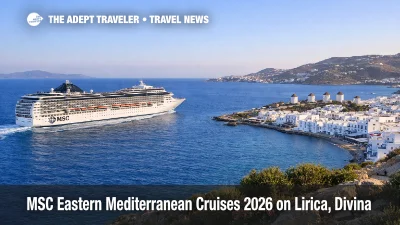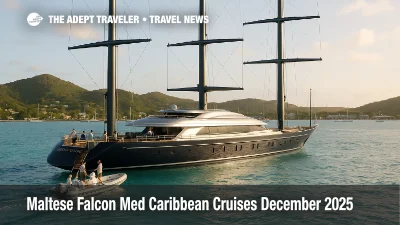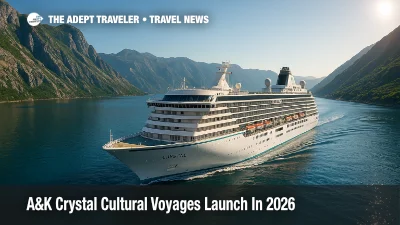Montenegro
Dreaming of an extraordinary escape that tantalizes your senses with a blend of mesmerizing natural landscapes, historic treasures, and intoxicating Adriatic beauty? Travel to Montenegro, a hidden gem in Southern Europe, that promises an unforgettable adventure for every kind of traveler. Nestled between rugged mountains and the sparkling Adriatic Sea, Montenegro boasts a diverse terrain that invites you to explore its stunning beaches, striking fjords, and lush forests. Whether you're trekking through the dramatic Durmitor National Park, a UNESCO World Heritage site, or basking in the sun on the iconic beaches of the Budva Riviera, Montenegro brims with unique experiences. The charming medieval town of Kotor, with its winding cobbled streets and well-preserved Venetian architecture, offers a magical dive into history and culture, while the vibrant nightlife and luxury resorts of Budva cater to those looking for a lively retreat. Year-round, adventurers can immerse themselves in rafting on the Tara River, skiing in the winter wonderland of the Bjelasica Mountains, or sailing along the tranquil Bay of Kotor. Delectable Montenegrin cuisine, with its blend of Mediterranean and Balkan flavors, will satiate your palate as you dine overlooking stunning vistas. Travel to Montenegro, a place where every turn reveals a new breathtaking view and where the blend of natural beauty, cultural depth, and warm hospitality creates a travel experience like no other. Whether you're seeking relaxation, adventure, or a rich historical journey, Montenegro invites you to unravel its charms and make memories that will last a lifetime.
The History of Montenegro
Montenegro, a gem in southeastern Europe, offers an intoxicating blend of history, culture, and natural beauty that beckons travelers from around the globe. Traveling to Montenegro is more than a vacation; it's a journey through centuries of vibrant history and dynamic cultural shifts. Its stunning coastline along the Adriatic Sea is punctuated by medieval towns and fortified cities, each with its own rich narrative waiting to be discovered.
Ancient Beginnings
The history of Montenegro dates back to the early Illyrians who settled in the area during the prehistoric period. As you travel to Montenegro, you'll find remnants of these ancient inhabitants etched into the landscape. The Roman Empire later established significant presence here, leaving behind an indelible mark. Ruins of Roman cities, such as Doclea near modern-day Podgorica, provide a fascinating glimpse into the classical past. Walking through these archaeological sites, visitors can almost hear the echoes of a bygone era, enhancing the allure of Montenegro as a travel destination steeped in antiquity.
Medieval Montenegro
During the medieval period, Montenegro experienced a series of profound transformations. The formation of the Principality of Zeta in the 14th century marked a significant milestone. The fortified city of Kotor, a UNESCO World Heritage Site, stands as a testament to this era. Kotor's well-preserved medieval architecture and maze-like streets make it a must-visit for history enthusiasts traveling to Montenegro. As you stroll through its ancient towns, it's impossible not to feel the weight of history that clings to every cobblestone. It's an extraordinary opportunity to journey back in time and explore the fusion of Italian Renaissance and Balkan influences.
Struggles and Resilience
The Ottoman Empire's influence over Montenegro in the 15th century introduced a period of significant resistance and resilience among the Montenegrin people. This era witnessed numerous battles and monumental efforts to preserve their autonomy and cultural identity. Travel to Montenegro and immerse yourself in stories of heroism that are retold through historic monuments and oral traditions. The country’s diverse heritage is further enriched by Venetian, Austro-Hungarian, and French nuances, making it a rich tapestry of European history.
Modern Transformation
Montenegro's modern history is equally compelling, particularly its journey to independence in 2006. Traveling to Montenegro today offers a unique opportunity to witness a country that has successfully navigated through the turbulence of history to emerge as an independent nation. Modern Montenegro seamlessly blends the old with the new. Visitors to the capital city, Podgorica, will find contemporary comforts set against a backdrop of historical landmarks, thus offering a comprehensive travel experience. From the rugged mountains of Durmitor, a UNESCO World Heritage Site, to the serene beaches of Budva, Montenegro presents a multitude of historical narratives waiting to be explored.
Any journey, especially to a country as richly historical as Montenegro, promises a rewarding experience. Whether you're drawn to ancient ruins, medieval fortresses, or modern historical milestones, traveling to Montenegro will satisfy your wanderlust and deepen your appreciation for the resilience and cultural diversity of this remarkable Balkan nation. Embark on this unforgettable journey and allow the rich history of Montenegro to captivate your imagination.
The Culture of Montenegro
Travel to Montenegro and immerse yourself in a culture that is as rich and diverse as its breathtaking landscapes. Nestled in southeastern Europe along the Adriatic Sea, Montenegro offers a unique blend of history, tradition, and modernity. The people of Montenegro are known for their hospitality and warmth, welcoming travelers with open arms. Whether you are wandering through the charming coastal towns of Kotor and Budva or exploring the rugged terrain of the Durmitor National Park, the spirit of Montenegro is palpable in every corner.
Historical Richness
Montenegro's history is a tapestry woven with threads of various cultures and empires. From the ancient Romans to the Venetians and Ottomans, each has left an indelible mark on Montenegrin culture. When you travel to Montenegro, you can witness this confluence of civilizations through its architecture, cuisine, and traditions. The Old Town of Kotor, a UNESCO World Heritage Site, is a living museum where cobblestone streets wind through medieval structures, churches, and fortifications. Visiting these historic sites provides a deep dive into the past, allowing travelers to experience the cultural metamorphosis Montenegro has undergone over millennia.
Vibrant Local Traditions
The essence of Montenegro is best captured in its local traditions and festivals. Montenegrins take immense pride in their folklore, music, and dance. One of the best times to travel to Montenegro is during the numerous local festivals that take place throughout the year. Events such as the Kotor Carnival and the Boka Nights bring communities together in spirited celebrations filled with colorful costumes, traditional music, and dance. These festivals offer travelers an unparalleled glimpse into the lively culture and heritage of Montenegro, ensuring an unforgettable cultural experience.
Culinary Delights
When you travel to Montenegro, prepare your taste buds for a culinary adventure. Montenegrin cuisine is a delightful mix of Mediterranean and Middle Eastern influences, featuring a variety of fresh seafood, meats, cheeses, and vegetables. Local specialties such as Njeguški pršut (smoked ham), Ka?amak (a traditional dish made from potatoes and cheese), and fresh seafood caught daily from the Adriatic Sea are must-tries. Eating in Montenegro is not just about the food; it's about the experience of dining al fresco in picturesque settings, whether you are enjoying a meal with a view of the Bay of Kotor or in a quaint mountain village.
Travel to Montenegro and discover a cultural treasure trove that offers something for everyone. Whether you are a history buff, a foodie, or someone who simply enjoys immersing in local traditions, Montenegro provides an enriching cultural experience that will leave a lasting impression. The warmth of its people, the richness of its heritage, and the beauty of its landscapes make Montenegro an unmissable destination for cultural travelers.
The Food of Montenegro
When you travel to Montenegro, you'll discover that its culinary scene is as rich and diverse as its stunning landscapes. Nestled between the Adriatic Sea and imposing mountain ranges, Montenegro offers a unique blend of Mediterranean and Balkan flavors that are sure to tantalize your taste buds. Noticeably different from its neighboring countries, Montenegro's cuisine is a harmonious celebration of fresh seafood, local meats, and organic produce, making it a must-visit destination for food lovers.
Authentic Montenegrin Flavors
One of the highlights when you travel to Montenegro is the opportunity to savor authentic Montenegrin flavors. The country's cuisine heavily emphasizes local ingredients that are often farmed or fished fresh daily. Olive oil, aromatic herbs, and seasonal vegetables frequently grace the table, giving each dish a burst of natural flavor. Don't miss out on tasting "Njeguški pršut," a smoked ham delicacy unique to Montenegro, as well as "Kacamak," a hearty dish made from potatoes and cheese that provides a delightful taste of traditional Montenegrin comfort food. The country’s wines, often overshadowed by Italy and France, are imbued with a unique character, especially the indigenous Vranac grape variety that produces robust red wines.
Seafood Extravaganza
Travelers to Montenegro will also find themselves in a seafood haven, courtesy of its extensive Adriatic coastline. From succulent octopus salad to grilled Adriatic squid, the seafood offerings are endless. Montenegro’s coastal towns, particularly Kotor and Budva, are well-known for their exquisite seafood restaurants. Here, you can enjoy freshly caught fish prepared in a myriad of ways—oven-baked, grilled, or even served raw in tartare form. Pair these delectable plates with a glass of chilled Montenegrin white wine, such as Krsta?, and you'll be experiencing the local dining culture at its finest.
Culinary Excursions and Local Markets
Beyond just dining in restaurants, travel to Montenegro offers unique culinary excursions that can deepen your appreciation for local flavors. Consider embarking on a wine tour in the picturesque vineyards of the country's central region or exploring the weekly farmer's markets. These markets are bustling centers of activity where you can purchase an array of local cheeses, meats, and produce. Engage with the friendly vendors and learn about the traditional methods used to prepare and preserve these foods. These experiences provide a tactile and immersive way to connect with Montenegro's culinary heritage.
Modern Culinary Innovations
While traditional foods are a cornerstone of Montenegrin cuisine, a new wave of innovative chefs is putting a modern twist on age-old recipes. Restaurants in Podgorica, the capital city, are increasingly offering fusion dishes that incorporate global flavors while staying true to Montenegrin roots. These establishments often feature menus that change with the seasons, ensuring the freshest ingredients are used. The growing emphasis on farm-to-table dining in Montenegro ensures that every meal is not just delicious but also sustainably sourced.
In summary, when you travel to Montenegro, you're in for an unparalleled culinary adventure. From traditional dishes and fresh seafood to modern culinary innovations, Montenegro's gastronomic offerings are a delightful exploration of flavors. Whether you're dining in a coastal town or exploring a local market, each gastronomic experience provides a deeper understanding of the country's rich cultural heritage. Don't miss the chance to embark on this mouthwatering journey; travel to Montenegro and let your taste buds explore the authentic and diverse flavors that make this destination a true food lover's paradise.
What to See and Do in Montenegro
Traveling to Montenegro promises a myriad of breathtaking landscapes, historic sites, and delightful culinary experiences that every traveler should eagerly explore. This stunning Balkan country offers a diverse range of activities and experiences that will leave you enchanted. Here are ten detailed recommendations for travelers planning their next adventure in Montenegro.
1. Explore the Bay of Kotor
Kotor, Montenegro, offers one of the most picturesque bays in the world. The Bay of Kotor is a UNESCO World Heritage Site, renowned for its stunning fjord-like appearance, winding coastline, and medieval towns. Travelers should take a boat tour to visit key sites such as Our Lady of the Rocks, a man-made island with a beautiful church and museum. Walking through the narrow streets of Old Town Kotor, with its ancient city walls, quaint shops, and historic buildings, is a journey back in time.
2. Visit Sveti Stefan
Travel to the exclusive islet of Sveti Stefan, Montenegro, which used to be a fortified village and is now a luxurious resort. This uniquely picturesque spot features red-roofed buildings and cobblestone alleyways. Though the island itself is accessible mainly to guests of the resort, the surrounding beaches, like Milo?er Beach and Queen's Beach, are perfect for sunbathing and offer views that are nothing short of spectacular.
3. Discover Durmitor National Park
Nature enthusiasts should not miss Durmitor National Park, located near the town of Žabljak, Montenegro. The park boasts stunning mountain ranges, glacial lakes known as "mountain eyes," and the Tara River Canyon, the deepest canyon in Europe. Activities include hiking, rafting on the Tara River, and skiing during the winter months. The highlight is Bobotov Kuk, the highest peak, offering stunning panoramic views.
4. Wander Through Perast
The small town of Perast, Montenegro, is a hidden gem with its beautiful baroque architecture and historical significance. The narrow streets and well-preserved buildings reflect the town’s rich maritime heritage. Don’t miss the Church of St. Nicholas and the chance to take a boat to the nearby islands of Our Lady of the Rocks and St. George.
5. Relax in Ulcinj
Ulcinj, Montenegro, offers a different atmosphere with its long sandy beaches and rich history influenced by various cultures. One must-visit spot is the expansive Velika Plaža, or "Long Beach," which stretches for about 13 kilometers. Explore the old town with its Ottoman architecture, try kite surfing, and visit the Ada Bojana island for an unforgettably serene experience.
6. Indulge in Local Cuisine
No travel to Montenegro is complete without tasting its local cuisine. Montenegrin food is a delightful blend of Mediterranean and Balkan influences. Key dishes to try include Njeguški pršut (smoked ham), Ka?amak (a polenta-like dish), and freshly caught seafood. Visit traditional restaurants in Cetinje, Montenegro, for an authentic dining experience.
7. Experience Biogradska Gora
Biogradska Gora National Park, located in the Bjelasica mountains, Montenegro, is famous for its ancient forest and serene Biogradsko Lake. This park is one of the last three large virgin forests in Europe. It's a paradise for hikers and nature lovers, offering various trails that wind through centuries-old trees and pristine nature.
8. Visit the Ostrog Monastery
The Ostrog Monastery, situated near Nikši?, Montenegro, is one of the most important pilgrimage sites in the Balkans. Carved into a vertical cliff face, this 17th-century Serbian Orthodox monastery offers breathtaking views and a profound spiritual experience. It's an essential visit for those keen on history and architecture.
9. Explore Lake Skadar
Shared between Montenegro and Albania, Lake Skadar is the largest lake in Southern Europe. The Montenegrin side is known for its wild beauty, diverse bird species, and charming fishing villages. Travelers can enjoy boat tours, kayak excursions, or simply relax at one of the lakeside wineries. Virpazar is a great starting point for exploring this natural wonder.
10. Discover the Blue Cave
Last but not least is the Blue Cave, located on the Lustica Peninsula near Herceg Novi, Montenegro. This stunning natural wonder is accessible only by boat and is famous for its crystal-clear, blue-hued waters, which reflect sunlight in a surreal manner. Swimming in the Blue Cave is a magical experience that should not be missed.
With so much to see and do, traveling to Montenegro offers experiences that cater to a wide range of interests, ensuring every traveler leaves with unforgettable memories.
Why You Should Travel to Montenegro
Travel enthusiasts from around the globe are increasingly enchanted by the allure of Montenegro. This Balkan country, nestled along the Adriatic Sea, offers a breathtaking blend of natural beauty, rich history, and cultural diversity. For those who travel to Montenegro, they often find themselves captivated by its pristine beaches, mountain ranges, and medieval towns. The Bay of Kotor, with its dramatic cliffs and serene waters, is a UNESCO World Heritage site that provides a mesmerizing backdrop for travelers seeking both relaxation and adventure. Beyond its natural beauty, Montenegro’s centuries-old architecture, with fortified towns like Kotor and Budva, adds layers of historical intrigue and charm.
Furthermore, Montenegro's appeal extends to its vibrant cultural scene and diverse culinary delights. Travelers are drawn to the country's unique mix of Mediterranean and Slavic influences, which are evident in its festivals, music, and traditional cuisine. Whether dining on fresh seafood along the coast or savoring hearty mountain fare inland, food lovers will find plenty to excite their palates. The friendly locals add to the appeal, welcoming travelers with warmth and hospitality that makes everyone feel at home. Montenegro's relatively small size also means that visitors can easily travel between stunning coastlines, lush forests, and historic towns, making it a versatile destination perfect for diverse interests.
For the more adventurous traveler, Montenegro offers an array of outdoor activities, from hiking in the picturesque Durmitor National Park to white-water rafting on the Tara River. The country’s varied landscape provides countless opportunities for exploring, whether it be through hidden coves, ancient castles, or along scenic mountain trails. The well-preserved natural environment and biodiversity make Montenegro a haven for nature enthusiasts and eco-tourists alike. Its national parks and protected areas are not just a feast for the eyes but also a sanctuary for numerous species of flora and fauna, making each travel experience to Montenegro unique and memorable.
Why You Must Travel to Montenegro
Considering all these incredible attributes, Montenegro should be at the top of your travel list. Imagine exploring a destination where you can discover medieval towns, indulge in delectable cuisine, and immerse yourself in stunning natural landscapes all in one trip. With its welcoming atmosphere, rich history, and diverse activities, Montenegro offers an unparalleled travel experience that caters to all types of travelers. Whether you're seeking relaxation, adventure, or cultural enrichment, travel to Montenegro promises to fulfill all your desires. Don’t miss out on the opportunity to experience the enchanting beauty and vibrant culture of this Balkan gem.
Tips & Tricks for Traveling in Montenegro
Traveling to Montenegro offers an exceptional experience filled with stunning landscapes, rich history, and vibrant culture. To ensure you make the most out of your journey, we've compiled ten detailed tips and tricks that will enhance your travel to Montenegro. Whether you're a first-time visitor or a seasoned traveler, these insights will make your Montenegro adventure unforgettable.
1. Visit in the Shoulder Season
One of the best tips for travel to Montenegro is to visit during the shoulder season, which typically spans from April to June and September to October. During these months, you'll experience milder weather, fewer tourists, and often more affordable accommodations. This allows you to explore popular attractions like Kotor, Budva, and Durmitor National Park without the heavy crowds that summer months bring.
2. Utilize Local Transportation
Montenegro's public transportation system is both efficient and budget-friendly. Utilizing buses and trains to travel to various parts of Montenegro offers you an authentic experience while saving money. The bus network is extensive and connects all major cities and towns. For a leisurely travel experience, consider taking a scenic train ride from Bar to Belgrade, which offers breathtaking views of Montenegro's countryside.
3. Rent a Car for Remote Destinations
Though public transport is reliable, renting a car provides the flexibility to explore Montenegro’s less accessible regions, like the Bay of Kotor or the stunning Durmitor massif. Ensure you book a car in advance, especially during peak travel seasons. Keep in mind that roads can be narrow and winding, so drive cautiously and take your time.
4. Explore Montenegro's National Parks
Montenegro boasts five national parks, each offering unique landscapes and activities. Durmitor National Park is perfect for hiking, skiing, and rafting, while Biogradska Gora is home to one of Europe’s last remaining primeval forests. Lov?en National Park offers panoramic views of the Bay of Kotor and is home to the Mausoleum of Njegoš. Designing your travel itinerary to include these parks will provide a well-rounded experience of Montenegro’s natural beauty.
5. Savor Local Cuisine
Montenegro’s culinary scene is diverse and flavorful. Be sure to try traditional dishes like Njeguški pršut (smoked ham), ka?amak (a potato-based dish), and seafood from the Adriatic. Pair your meals with local wines like Vranac or Krsta? for an authentic Montenegrin experience. Dining at family-owned konobas (taverns) offers both delicious food and a glimpse into the country's warm hospitality.
6. Learn Basic Montenegrin Phrases
While English is widely spoken in tourist areas, learning a few basic Montenegrin phrases can go a long way in enhancing your travel experience. Simple greetings like "Zdravo" (Hello) and "Hvala" (Thank you) can make interactions smoother and more pleasant. The locals appreciate the effort and it adds a layer of cultural immersion to your travel to Montenegro.
7. Respect Local Customs and Traditions
Montenegro is a country with rich cultural traditions. Show respect by dressing modestly when visiting religious sites, and always ask for permission before taking photographs of people. Participating in local festivals, such as the Kotor Carnival or the Mimosa Festival in Herceg Novi, can be a great way to engage with Montenegro’s vibrant culture.
8. Stay Connected with SIM Cards
Staying connected during your travels in Montenegro is essential for navigation and communication. Purchase a local SIM card upon arrival, which offers affordable data packages. Major network providers like Telenor and M:tel have extensive coverage, ensuring you stay connected throughout your journey.
9. Pack for Varied Weather
Montenegro’s geography means varied weather conditions. When planning your travel to Montenegro, it’s essential to pack appropriately for different climates. If you're heading to the mountains, bring warm clothing regardless of the season, as it can get chilly. Conversely, if you are visiting coastal areas, summer wear and sunscreen are a must.
10. Take Out Travel Insurance
Travel insurance is crucial for any traveler, and Montenegro is no exception. Given the country's diverse outdoor activities, from hiking to water sports, having comprehensive travel insurance can cover any unforeseen medical expenses or travel disruptions. It provides peace of mind so you can fully enjoy your travel to Montenegro.
By following these tips and tricks, your travel to Montenegro will be smoother, richer, and more enjoyable. Embrace everything this magnificent country has to offer, and create lasting memories of your Montenegrin adventure.
Other Places You Might Like
Dubrovnik, Croatia - For those who revel in the blend of stunning coastal landscapes and rich historical tapestry that Montenegro offers, Dubrovnik in Croatia is a must-visit. This city, often referred to as the "Pearl of the Adriatic," boasts a magnificent old town encircled by massive stone walls completed in the 16th century. Walking the walls provides breathtaking views of the dazzling blue Adriatic Sea and the terracotta rooftops of the old houses, akin to the scenic vistas you would find when you travel to Montenegro. The narrow, cobbled streets, historic baroque buildings, and the vibrant cultural scene make Dubrovnik a treasure trove for explorers looking to dive into a place teeming with history and charm, much like Montenegro.
Kotor, Montenegro - When you travel to Montenegro, Kotor is a city that leaves an indelible mark due to its enchanting medieval architecture and imposing mountainous backdrop. Nestled on the coast of the Boka Bay, Kotor offers an intoxicating mix of stunning natural scenery and well-preserved ancient buildings. A UNESCO World Heritage site, Kotor's maze-like streets invite you to discover its historic churches, quaint cafes, and local artisan shops. The panoramic views from the top of the Kotor Fortress are unforgettable, resembling the scenic beauty found throughout Montenegro.
Mostar, Bosnia and Herzegovina - Mostar, a picturesque city in Bosnia and Herzegovina, offers a unique charm that can captivate those who love Montenegro. The city is renowned for its iconic Stari Most (Old Bridge), an elegant Ottoman-era bridge that spans the Neretva River, symbolizing reconciliation and unity. The old town, with its bustling bazaar, traditional craft shops, and delightful riverside cafes, immerses visitors in a vibrant cultural atmosphere reminiscent of the historic towns of Montenegro. A stroll through Mostar reveals a blend of architectural beauty and a poignant history that echoes the rich dynamics found in Montenegro.
Lake Bled, Slovenia - For those who appreciate Montenegro's pristine nature and captivating landscapes, Lake Bled in Slovenia is a destination not to be missed. This enchanting lake, with its emerald-green waters and the fairy-tale castle perched high above, offers a serene escape and a plethora of outdoor activities. Exploring the surrounding Julian Alps, enjoying a traditional pletna boat ride to the tiny island in the middle of the lake, and hiking up to Bled Castle evoke the same sense of awe and adventure one experiences when exploring Montenegro’s natural wonders.
Sarajevo, Bosnia and Herzegovina - A city which mirrors the cultural confluence found in Montenegro is Sarajevo, Bosnia and Herzegovina's intriguing capital. Sarajevo’s diverse heritage is palpable as you wander through the historic Baš?aršija bazaar, where Ottoman and Austro-Hungarian influences blend harmoniously. The city's vibrant street life, welcoming locals, lush surroundings, and historically significant sites like the Latin Bridge bring a nuanced and enriching travel experience similar to when traveling to Montenegro. Sarajevo’s unique blend of Eastern and Western cultures provides a captivating narrative that complements a travel enthusiast's love for Montenegro’s rich cultural mosaic.
Hvar, Croatia - Hvar, an island town off the Dalmatian coast of Croatia, appeals to those who find joy in Montenegro’s coastal allure. Surrounded by crystal-clear waters, lavender fields, and vineyards, Hvar boasts picturesque beaches, ancient ruins, and a buzzing nightlife. The town's center, with medieval architecture and a sprawling 13th-century fortress offering panoramic views, melds historical charm with contemporary vibrancy, akin to the coastal towns of Montenegro. Exploring Hvar’s natural beauty and lively ambiance offers a refreshing yet familiar vibe for any lover of Montenegro’s coastal wonders.
Rovinj, Croatia - Situated on the western coast of Croatia's Istrian Peninsula, Rovinj is a quaint and picturesque town reminiscent of Montenegro’s Adriatic allure. Known for its colorful houses, narrow winding streets, and the towering Church of St. Euphemia, Rovinj exudes a charm that captures the hearts of travelers. The town’s scenic harbor, cobblestone alleyways, and stunning sea views provide an idyllic setting much like the serene coastal atmosphere found in Montenegro. Enjoying a meal in one of Rovinj’s waterfront restaurants while soaking in the views makes for a perfect travel experience that parallels the magic of Montenegro.
MSC Eastern Mediterranean Cruises 2026 on Lirica, Divina

Maltese Falcon Med Caribbean Cruises December 2025

New Heathrow Flights To Tivat And Guernsey From 2026

Intrepid Adds 28 Active Trips To 2026 Lineup

A&K Crystal Cultural Voyages Launch In 2026

Celestyal Cruises Redefines Shore Excursions

